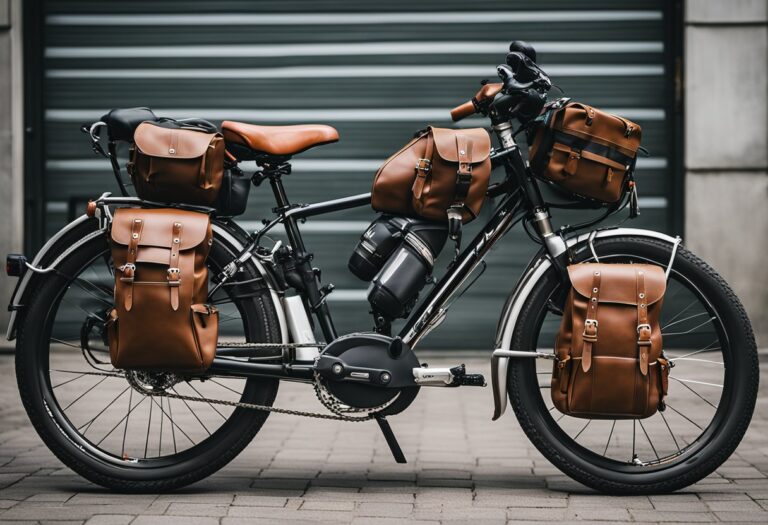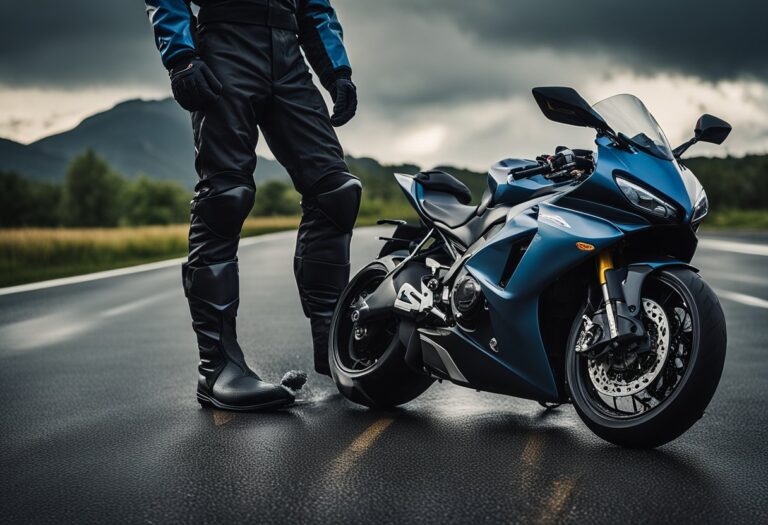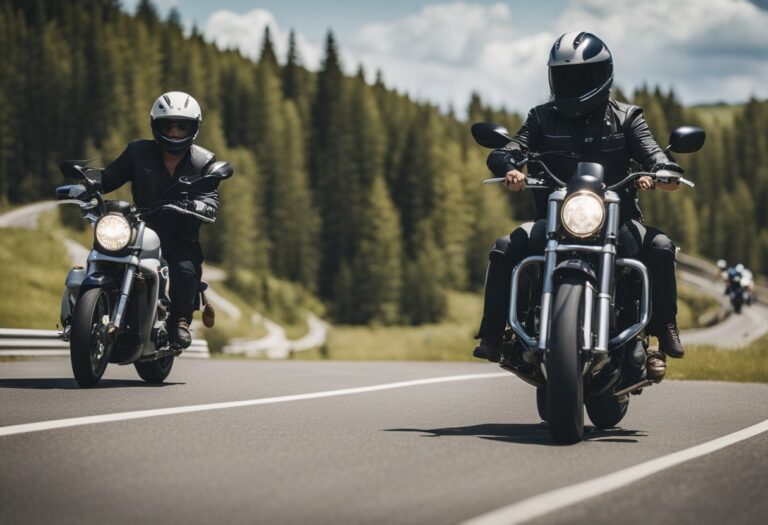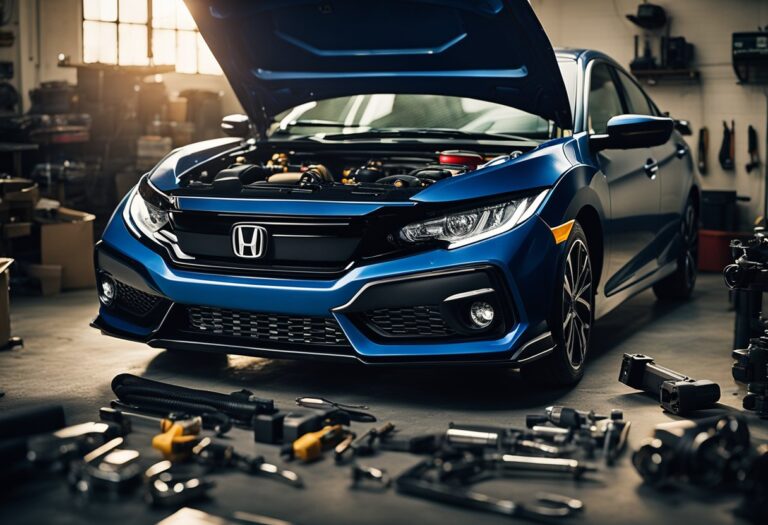How to Load and Transport a Motorcycle: A Comprehensive Guide
Loading and transporting a motorcycle can be a daunting task, especially for those who are new to the process. However, with the right equipment and knowledge, it can be done safely and efficiently. This article will provide step-by-step instructions on how to load and transport a motorcycle, from preparing the motorcycle to post-transport checks.

Firstly, it is important to prepare the motorcycle before loading it onto a transport vehicle. This includes checking the tire pressure, removing any loose items, and securing the motorcycle’s battery. Additionally, it is recommended to cover the motorcycle with a protective cover to prevent any damage during transport.
Choosing the right transport equipment is also crucial in ensuring a safe and successful transport. Depending on the distance and mode of transport, options range from trailers to trucks to specialized motorcycle carriers. It is important to choose the equipment that best suits the motorcycle’s size and weight, as well as the route and conditions of transport.
Key Takeaways
- Proper preparation of the motorcycle before transport is essential for a safe and successful transport.
- Choosing the right transport equipment is crucial in ensuring a safe and efficient transport.
- Loading and unloading the motorcycle should be done with caution and proper technique to prevent any damage or injury.
Preparing the Motorcycle

Maintenance Check
Before loading and transporting a motorcycle, it is important to conduct a thorough maintenance check to ensure that the motorcycle is in good condition. This includes checking the brakes, tires, and lights to make sure they are working properly. The chain or belt should also be inspected for proper tension and lubrication.
Fuel and Fluids
It is important to check the fuel and fluid levels of the motorcycle before loading and transporting it. The fuel tank should be filled to prevent sloshing during transport, and the oil level should be checked to ensure that the engine is properly lubricated. Other fluids, such as brake and coolant fluids, should also be checked and topped off if necessary.
Securing Loose Parts
Loose parts on a motorcycle can be dangerous during transport, so it is important to secure them before loading the motorcycle onto a trailer or truck. This includes removing any detachable parts, such as mirrors or saddlebags, and securing them separately. The kickstand should also be secured to prevent it from accidentally deploying during transport.
By conducting a thorough maintenance check, checking fuel and fluid levels, and securing loose parts, the motorcycle will be ready for safe and secure transport.
Choosing the Right Transport Equipment

Motorcycle Carriers
When it comes to transporting a motorcycle, a carrier is a great option for those who don’t have a trailer or a truck. A motorcycle carrier is a platform that attaches to the hitch of a vehicle and allows the motorcycle to be loaded and transported safely. There are many different types of carriers available on the market, ranging from basic models to more advanced carriers that come with features like ramps, tie-downs, and wheel chocks.
When choosing a motorcycle carrier, it’s important to consider the weight and size of your bike, as well as the weight capacity of the carrier. It’s also important to make sure that the carrier is compatible with your vehicle’s hitch. Some carriers are designed specifically for certain types of vehicles, while others are more universal.
Trailers
Another option for transporting a motorcycle is a trailer. Trailers come in a variety of sizes and styles, from small single-bike trailers to larger trailers that can transport multiple bikes. When choosing a trailer, it’s important to consider the weight and size of your bike, as well as the weight capacity of the trailer. It’s also important to make sure that the trailer is compatible with your vehicle’s hitch.
Trailers can be a great option for those who need to transport multiple bikes, or for those who want to transport their bike along with other gear or equipment. They can also be a good choice for longer trips, as they provide more protection from the elements than a carrier.
Tie-Down Straps
No matter what type of transport equipment you choose, it’s important to use high-quality tie-down straps to secure your motorcycle during transport. Tie-down straps come in a variety of styles and sizes, and it’s important to choose the right ones for your bike.
When using tie-down straps, it’s important to make sure that they are secured tightly and that they are not rubbing against any part of the bike that could cause damage. It’s also important to make sure that the bike is balanced and stable during transport, to prevent any shifting or movement that could cause damage or instability.
Overall, choosing the right transport equipment is an important part of safely and securely transporting a motorcycle. Whether you choose a carrier, a trailer, or a combination of both, it’s important to make sure that you have the right equipment for your bike and that you use it properly to ensure a safe and successful transport.
Loading the Motorcycle

Using Ramps
When loading a motorcycle onto a truck or trailer, it is important to use a ramp that can safely support the weight of the bike. The ramp should be made of a sturdy material, such as aluminum or steel, and have a non-slip surface to prevent the motorcycle from slipping during loading.
To use the ramp, position it securely against the truck or trailer and ensure that it is at a safe angle for the motorcycle to climb. The rider should then slowly ride the motorcycle up the ramp, keeping it in a low gear and maintaining a steady speed. It is important to keep the motorcycle centered on the ramp to prevent it from tipping over.
Balancing and Positioning
Once the motorcycle is on the truck or trailer, it must be properly balanced and positioned to prevent it from shifting during transport. The motorcycle should be centered on the trailer and positioned so that the weight is evenly distributed.
It is also important to ensure that the motorcycle is securely upright and cannot tip over during transport. This can be achieved by using straps or other tie-downs to secure the motorcycle to the trailer or truck.
Securing the Motorcycle
To secure the motorcycle, use high-quality tie-down straps that are rated to support the weight of the bike. The straps should be placed at strategic points on the motorcycle, such as the handlebars, frame, or foot pegs, to prevent it from shifting or tipping over during transport.
It is important to ensure that the straps are tightened securely and that the motorcycle is stable before beginning transport. Check the straps periodically during transport to ensure that they remain tight and that the motorcycle is still properly positioned and balanced.
Transporting the Motorcycle

Driving Tips
Transporting a motorcycle is not the same as driving a car or truck. The rider must be aware of the motorcycle’s weight, size, and balance. It is essential to secure the motorcycle correctly to avoid damage during transport. Before driving, the rider should check the motorcycle’s tie-downs, straps, and other attachments. The rider must also ensure that the motorcycle is balanced and stable on the trailer or truck bed.
During transport, the rider must be cautious when turning, braking, and accelerating. The rider should also avoid sudden movements that could cause the motorcycle to tip over or shift. It is also essential to maintain a safe speed and distance from other vehicles on the road.
Weather Considerations
Weather conditions can affect the motorcycle’s stability during transport. The rider must be aware of the weather forecast and plan accordingly. It is best to avoid transporting a motorcycle during heavy rain, snow, or strong winds. If it is necessary to transport the motorcycle in adverse weather conditions, the rider should reduce speed and maintain a safe distance from other vehicles.
Regular Checks en Route
During transport, the rider must periodically check the motorcycle’s tie-downs, straps, and other attachments. The rider should also check the motorcycle’s condition, including the tires, brakes, and other components. If there are any issues, the rider should stop and address them immediately.
In addition, the rider should take breaks regularly to avoid fatigue. It is best to stop every two hours or so to stretch, hydrate, and rest. This will help the rider stay alert and focused during transport.
Transporting a motorcycle requires careful planning, preparation, and execution. By following these driving tips, weather considerations, and regular checks en route, the rider can transport the motorcycle safely and efficiently.
Unloading the Motorcycle

Safety Precautions
Before unloading a motorcycle, it is important to take necessary safety precautions to prevent any accidents or injuries. The following safety measures should be taken:
- Wear proper safety gear such as gloves, helmet, and protective clothing.
- Ensure the unloading area is clear of obstacles and debris.
- Make sure the motorcycle is in neutral and the kickstand is down.
- Have an assistant to help stabilize the motorcycle during unloading.
Removing Tie-Downs
The first step in unloading a motorcycle is to remove the tie-downs. The tie-downs should be removed in the reverse order they were secured. Start with the rear tie-downs, followed by the front tie-downs. As each tie-down is removed, the assistant should hold the motorcycle steady. Be sure to inspect the tie-downs for any damage before storing them away.
Using Ramps for Unloading
Using ramps to unload a motorcycle is a safe and effective method. There are two types of ramps available: straight ramps and arched ramps. Straight ramps are ideal for loading and unloading on flat surfaces, while arched ramps are better for uneven surfaces or steep inclines.
To use a ramp for unloading, follow these steps:
- Position the ramp securely against the unloading surface.
- Ensure the ramp is straight and level.
- Have the assistant hold the motorcycle steady while the rider walks it down the ramp.
- Walk the motorcycle down the ramp slowly and carefully, keeping the brakes engaged as needed.
By following these steps and taking necessary safety precautions, unloading a motorcycle can be a safe and easy process.
Post-Transport Checks

After transporting a motorcycle, it’s important to conduct some checks to ensure that the bike is in good condition and ready for use. Here are some post-transport checks that should be performed:
1. Check for Damage
Inspect the motorcycle for any damage that may have occurred during transportation. Look for scratches, dents, or any other signs of damage. If there is any damage, take pictures of it and report it to the transportation company or insurance provider.
2. Check the Tires
Check the tire pressure and make sure that the tires are properly inflated. If the tires are underinflated, it can cause handling issues and reduce fuel efficiency. Also, check the tires for any signs of damage, such as cuts, punctures, or bulges.
3. Check the Fluids
Check the oil, coolant, and brake fluid levels to ensure that they are at the proper levels. Low fluid levels can cause damage to the engine or brakes, and can also lead to decreased performance.
4. Check the Battery
Check the battery to ensure that it is properly charged and connected. A dead battery can prevent the motorcycle from starting, and can also cause damage to the electrical system.
5. Test Ride
Take the motorcycle for a short test ride to ensure that everything is working properly. Pay attention to the brakes, clutch, and throttle, and make sure that the motorcycle handles properly.
By performing these post-transport checks, you can ensure that your motorcycle is in good condition and ready for use.
Frequently Asked Questions

What is the safest method for loading a motorcycle onto a truck bed?
The safest method for loading a motorcycle onto a truck bed is to use a ramp and have someone assist you. Make sure the ramp is sturdy and secured properly to the truck bed. The person assisting you should hold the motorcycle steady while you slowly ride it up the ramp. Always make sure the motorcycle is centered on the ramp and that the ramp is at a low angle.
What are the necessary steps to secure a motorcycle on a trailer for transport?
To secure a motorcycle on a trailer for transport, first, make sure the trailer is level and secure. Then, use straps to tie down the motorcycle to the trailer. Place the straps over the handlebars and attach them to the trailer’s anchor points. Use additional straps to secure the rear of the motorcycle to the trailer. Always make sure the motorcycle is centered on the trailer and that the straps are tight and secure.
Can a motorcycle be safely transported in a van, and if so, how?
Yes, a motorcycle can be safely transported in a van. Remove the seats and any other obstructions to create enough space for the motorcycle. Use straps to tie down the motorcycle to the van’s anchor points. Make sure the motorcycle is centered and that the straps are tight and secure.
What equipment is essential for a single person to load a motorcycle into a truck?
Essential equipment for a single person to load a motorcycle into a truck includes a ramp, tie-down straps, and a wheel chock. The ramp should be sturdy and secured properly to the truck bed. The wheel chock should be placed at the end of the ramp to keep the motorcycle stable while loading. Use tie-down straps to secure the motorcycle to the truck bed.
How can you transport a motorcycle without using a truck or trailer?
A motorcycle can be transported without using a truck or trailer by using a motorcycle carrier that attaches to the hitch of a vehicle. The carrier should be sturdy and secured properly to the hitch. Use tie-down straps to secure the motorcycle to the carrier. Always make sure the motorcycle is centered on the carrier and that the straps are tight and secure.
What considerations should be taken into account when moving a motorcycle in limited space, such as a garage?
When moving a motorcycle in limited space, such as a garage, consider the size of the motorcycle and the space available. Use caution and move the motorcycle slowly to avoid hitting any obstacles. If possible, have someone assist you in moving the motorcycle. Always make sure the motorcycle is turned off and in neutral when moving it.






